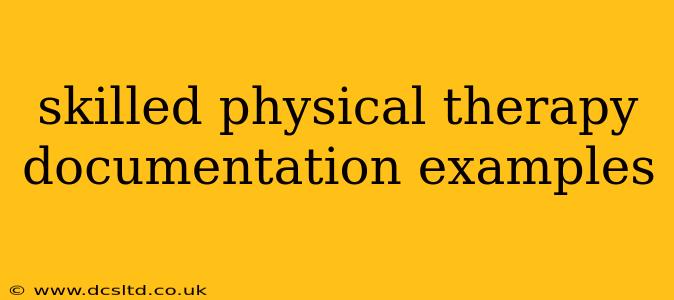Effective physical therapy documentation is crucial for ensuring patient safety, justifying medical necessity, and facilitating communication among healthcare professionals. This guide provides examples of skilled physical therapy documentation, highlighting key elements and best practices. We'll cover different scenarios and demonstrate how to articulate patient progress and the rationale for interventions. Remember, this information is for educational purposes only and should not be considered a substitute for professional guidance or legal advice. Always adhere to your facility's specific documentation policies and procedures.
What Constitutes "Skilled" Physical Therapy?
Before diving into examples, let's clarify what makes physical therapy interventions "skilled." Skilled care requires the judgment, knowledge, and expertise of a licensed physical therapist. It goes beyond simple exercises and involves:
- Assessment: A comprehensive evaluation of the patient's condition, including medical history, functional limitations, and goals.
- Diagnosis: Identifying impairments and functional limitations that impede the patient's ability to participate in daily activities.
- Plan of Care: Developing a customized treatment plan based on the assessment and diagnosis, including specific interventions and measurable goals.
- Intervention: Applying skilled techniques and interventions, such as manual therapy, therapeutic exercise, and functional training, to address the patient's impairments.
- Progress Evaluation: Regularly monitoring the patient's progress, adjusting the treatment plan as needed, and documenting outcomes.
Skilled Physical Therapy Documentation Examples:
Here are some examples showcasing different aspects of skilled physical therapy documentation. Remember to tailor these examples to your specific patient and setting.
Example 1: Initial Evaluation
Patient: 65-year-old female with post-surgical knee osteoarthritis following a total knee arthroplasty (TKA) three weeks prior.
Subjective: Patient reports persistent pain (5/10 on a visual analog scale) in the right knee, especially with weight-bearing activities. She ambulates with a rolling walker and reports difficulty with stair negotiation and transfers. She desires to return to independent ambulation and participation in her gardening hobby.
Objective: Right knee exhibits decreased range of motion (ROM): flexion 90 degrees, extension 0 degrees. Muscle strength is 3/5 in the quadriceps and 4/5 in the hamstrings. Patient demonstrates impaired gait pattern with antalgic gait and decreased weight-bearing on the right leg. Pain is elicited with palpation of the medial joint line. Swelling is minimal.
Assessment: Post-surgical TKA with persistent pain, decreased ROM, muscle weakness, and impaired gait. This limits her ability to perform activities of daily living (ADLs) and participate in desired recreational activities.
Plan: Focus on pain management, improving ROM, increasing muscle strength, and improving gait mechanics. Interventions will include manual therapy, therapeutic exercise (focused on range of motion exercises, strengthening exercises, and gait training), patient education on proper joint protection techniques, and functional mobility training (transfers and stair climbing). Goals will be established in collaboration with the patient.
Example 2: Progress Note
Patient: Same patient as above, two weeks post-initial evaluation.
Subjective: Patient reports decreased pain (3/10) and increased confidence in weight-bearing. She reports less difficulty with transfers.
Objective: Right knee ROM improved to flexion 110 degrees, extension 5 degrees. Quadriceps strength improved to 4/5; hamstrings remain 4/5. Gait pattern shows improved weight-bearing and less antalgic gait. Patient completes 5 repetitions of sit-to-stand transfers without assistance.
Assessment: Patient is demonstrating progress towards goals. Continued improvement in ROM, strength, and gait is expected with ongoing therapy.
Plan: Continue with current treatment plan, progressing exercises as tolerated. Introduce more challenging exercises, including balance exercises and functional activities (e.g., practicing gardening-related movements).
Example 3: Discharge Summary
Patient: Same patient as above, four weeks post-initial evaluation.
Subjective: Patient reports minimal pain (1/10) and is able to perform all ADLs independently. She is able to participate in gardening with minimal limitations.
Objective: Right knee ROM is within normal limits. Muscle strength is 5/5 in the quadriceps and hamstrings. Patient demonstrates a normal gait pattern. She completes all functional tasks independently and safely.
Assessment: Patient has met her established goals and is ready for discharge. She is encouraged to continue a home exercise program to maintain her current level of function.
Plan: Discharge from physical therapy. Home exercise program provided. Follow-up with physician as needed.
Frequently Asked Questions (FAQ)
How often should I document my patient's progress?
The frequency of documentation depends on your setting and the patient's needs, but daily or every other day is typical for inpatients, while weekly or bi-weekly documentation may be sufficient for outpatients. Always document any significant changes in the patient's condition, regardless of the scheduled frequency.
What are the essential elements of skilled physical therapy documentation?
Essential elements include a thorough subjective assessment (patient's report), objective measurements (ROM, strength, gait), assessment (interpretation of findings), plan of care (interventions and goals), and progress notes that reflect changes over time.
How can I improve my physical therapy documentation skills?
Attend continuing education courses focused on documentation, utilize templates and checklists provided by your facility, and review examples of well-written documentation. Always ensure your documentation is accurate, concise, and clearly communicates the patient's progress and the rationale for your interventions.
By following these examples and incorporating best practices, you can ensure your physical therapy documentation is both accurate and comprehensive, supporting the quality of care you provide and the justification of your services. Remember to always consult with your facility's policies and professional resources for the most up-to-date and accurate guidance.
